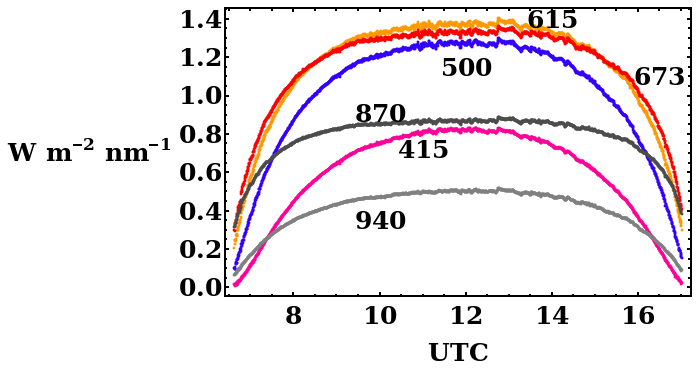|
Langley Extrapolation
Langley extrapolation is a method for determining the Sun's irradiance at the top of the atmosphere with ground-based instrumentation, and is often used to remove the effect of the atmosphere from measurements of, for example, aerosol optical thickness or ozone. It is based on repeated measurements with a sun photometer operated at a given location for a cloudless morning or afternoon as the Sun moves across the sky. It is named for American astronomer and physicist Samuel Pierpont Langley. Theory It is known from Beer's law that, for every instantaneous measurement, the ''direct-Sun irradiance'' ''I'' is linked to the ''solar extraterrestrial irradiance'' ''I''0 and the atmospheric optical depth \tau by the following equation: where ''m'' is a geometrical factor accounting for the slant path through the atmosphere, known as the airmass factor. For a plane-parallel atmosphere, the airmass factor is simple to determine if one knows the solar zenith angle θ: ''m'' = 1/cos(& ... [...More Info...] [...Related Items...] OR: [Wikipedia] [Google] [Baidu] |
Aerosol
An aerosol is a suspension of fine solid particles or liquid droplets in air or another gas. Aerosols can be natural or anthropogenic. Examples of natural aerosols are fog or mist, dust, forest exudates, and geyser steam. Examples of anthropogenic aerosols include particulate air pollutants, mist from the discharge at hydroelectric dams, irrigation mist, perfume from atomizers, smoke, steam from a kettle, sprayed pesticides, and medical treatments for respiratory illnesses. When a person inhales the contents of a vape pen or e-cigarette, they are inhaling an anthropogenic aerosol. The liquid or solid particles in an aerosol have diameters typically less than 1 μm (larger particles with a significant settling speed make the mixture a suspension, but the distinction is not clear-cut). In general conversation, ''aerosol'' often refers to a dispensing system that delivers a consumer product from a can. Diseases can spread by means of small droplets in ... [...More Info...] [...Related Items...] OR: [Wikipedia] [Google] [Baidu] |
Air Mass (astronomy)
In astronomy, air mass or airmass is a measure of the amount of air along the line of sight when observing a star or other celestial source from below Earth's atmosphere ( Green 1992). It is formulated as the integral of air density along the light ray. As it penetrates the atmosphere, light is attenuated by scattering and absorption; the thicker atmosphere through which it passes, the greater the attenuation. Consequently, celestial bodies when nearer the horizon appear less bright than when nearer the zenith. This attenuation, known as atmospheric extinction, is described quantitatively by the Beer–Lambert law. "Air mass" normally indicates ''relative air mass'', the ratio of absolute air masses (as defined above) at oblique incidence relative to that at zenith. So, by definition, the relative air mass at the zenith is 1. Air mass increases as the angle between the source and the zenith increases, reaching a value of approximately 38 at the horizon. Air mass can be les ... [...More Info...] [...Related Items...] OR: [Wikipedia] [Google] [Baidu] |
Refraction
In physics, refraction is the redirection of a wave as it passes from one medium to another. The redirection can be caused by the wave's change in speed or by a change in the medium. Refraction of light is the most commonly observed phenomenon, but other waves such as sound waves and water waves also experience refraction. How much a wave is refracted is determined by the change in wave speed and the initial direction of wave propagation relative to the direction of change in speed. For light, refraction follows Snell's law, which states that, for a given pair of media, the ratio of the sines of the angle of incidence ''θ1'' and angle of refraction ''θ2'' is equal to the ratio of phase velocities (''v''1 / ''v''2) in the two media, or equivalently, to the refractive indices (''n''2 / ''n''1) of the two media. :\frac =\frac=\frac Optical prisms and lenses use refraction to redirect light, as does the human eye. The refractive index of materials varies with the wa ... [...More Info...] [...Related Items...] OR: [Wikipedia] [Google] [Baidu] |
Rayleigh Scattering
Rayleigh scattering ( ), named after the 19th-century British physicist Lord Rayleigh (John William Strutt), is the predominantly elastic scattering of light or other electromagnetic radiation by particles much smaller than the wavelength of the radiation. For light frequencies well below the resonance frequency of the scattering particle (normal dispersion regime), the amount of scattering is inversely proportional to the fourth power of the wavelength. Rayleigh scattering results from the electric polarizability of the particles. The oscillating electric field of a light wave acts on the charges within a particle, causing them to move at the same frequency. The particle, therefore, becomes a small radiating dipole whose radiation we see as scattered light. The particles may be individual atoms or molecules; it can occur when light travels through transparent solids and liquids, but is most prominently seen in gases. Rayleigh scattering of sunlight in Earth's atmosphere cau ... [...More Info...] [...Related Items...] OR: [Wikipedia] [Google] [Baidu] |
Forrest Mims
Forrest M. Mims III is an American amateur scientist,'Country Scientist' starting column today in Express-News ForrestMims.org, October 30, 2006 magazine columnist, and author of ''Getting Started in Electronics'' and ''Engineer's Mini-Notebook'' series of instructional books that were originally sold in electronics stores and are still in print. Mims graduated from in 1966 with a major in government and minors in English and history. He became a commissioned officer in the |
Haze
Haze is traditionally an atmospheric phenomenon in which dust, smoke, and other dry particulates suspended in air obscure visibility and the clarity of the sky. The World Meteorological Organization manual of codes includes a classification of particulates causing horizontal obscuration into categories of fog, ice fog, steam fog, mist, haze, smoke, volcanic ash, dust, sand, and snow. Sources for particles that cause haze include farming (ploughing in dry weather), traffic, industry, volcanic activity and wildfires. Seen from afar (e.g. an approaching airplane) and depending on the direction of view with respect to the Sun, haze may appear brownish or bluish, while mist tends to be bluish grey instead. Whereas haze often is thought of as a phenomenon occurring in dry air, mist formation is a phenomenon in saturated, humid air. However, haze particles may act as condensation nuclei that leads to the subsequent vapor condensation and formation of mist droplets; such forms of ... [...More Info...] [...Related Items...] OR: [Wikipedia] [Google] [Baidu] |
Spectral Sensitivity
Spectral sensitivity is the relative efficiency of detection, of light or other signal, as a function of the frequency or wavelength of the signal. In visual neuroscience, spectral sensitivity is used to describe the different characteristics of the photopigments in the rod cells and cone cells in the retina of the eye. It is known that the rod cells are more suited to scotopic vision and cone cells to photopic vision, and that they differ in their sensitivity to different wavelengths of light. It has been established that the maximum spectral sensitivity of the human eye under daylight conditions is at a wavelength of 555 nm, while at night the peak shifts to 507 nm. In photography, film and sensors are often described in terms of their spectral sensitivity, to supplement their characteristic curves that describe their responsivity. A database of camera spectral sensitivity is created and its space analyzed. For X-ray films, the spectral sensitivity is chosen to b ... [...More Info...] [...Related Items...] OR: [Wikipedia] [Google] [Baidu] |
Photodiode
A photodiode is a light-sensitive semiconductor diode. It produces current when it absorbs photons. The package of a photodiode allows light (or infrared or ultraviolet radiation, or X-rays) to reach the sensitive part of the device. The package may include lenses or optical filters. Devices designed for use specially as a photodiode use a PIN junction rather than a p–n junction, to increase the speed of response. Photodiodes usually have a slower response time as their surface area increases. A photodiode is designed to operate in reverse bias. A solar cell used to generate electric solar power is a large area photodiode. Photodiodes are used in scientific and industrial instruments to measure light intensity, either for its own sake or as a measure of some other property (density of smoke, for example). A photodiode can be used as the receiver of data encoded on an infrared beam, as in household remote controls. Photodiodes can be used to form an optocoupler, allowing ... [...More Info...] [...Related Items...] OR: [Wikipedia] [Google] [Baidu] |
Interference Filter
An interference filter or dichroic filter is an optical filter that reflects one or more spectral bands or lines and transmits others, while maintaining a nearly zero coefficient of absorption for all wavelengths of interest. An interference filter may be high-pass, low-pass, bandpass, or band-rejection. An interference filter consists of multiple thin layers of dielectric material having different refractive indices. There also may be metallic layers. In its broadest meaning, interference filters comprise also etalons that could be implemented as tunable interference filters. Interference filters are wavelength-selective by virtue of the interference effects that take place between the incident and reflected waves at the thin-film boundaries. The important characteristic of the filter is the form of the leaving signal. It is considered that the best form is a rectangle. References Additional sources * *M. Bass, ''Handbook of Optics'' (2nd ed.) pp. 42.89-42.90 (1995) See al ... [...More Info...] [...Related Items...] OR: [Wikipedia] [Google] [Baidu] |
Light-emitting Diode
A light-emitting diode (LED) is a semiconductor device that emits light when current flows through it. Electrons in the semiconductor recombine with electron holes, releasing energy in the form of photons. The color of the light (corresponding to the energy of the photons) is determined by the energy required for electrons to cross the band gap of the semiconductor. White light is obtained by using multiple semiconductors or a layer of light-emitting phosphor on the semiconductor device. Appearing as practical electronic components in 1962, the earliest LEDs emitted low-intensity infrared (IR) light. Infrared LEDs are used in remote-control circuits, such as those used with a wide variety of consumer electronics. The first visible-light LEDs were of low intensity and limited to red. Early LEDs were often used as indicator lamps, replacing small incandescent bulbs, and in seven-segment displays. Later developments produced LEDs available in visible, ultraviolet ... [...More Info...] [...Related Items...] OR: [Wikipedia] [Google] [Baidu] |
Solar Cell
A solar cell, or photovoltaic cell, is an electronic device that converts the energy of light directly into electricity by the photovoltaic effect, which is a physical and chemical phenomenon.Solar Cells chemistryexplained.com It is a form of photoelectric cell, defined as a device whose electrical characteristics, such as current, voltage, or , vary when exposed to light. Individual solar cell devices are often the electrical building blocks of [...More Info...] [...Related Items...] OR: [Wikipedia] [Google] [Baidu] |




.jpg)



